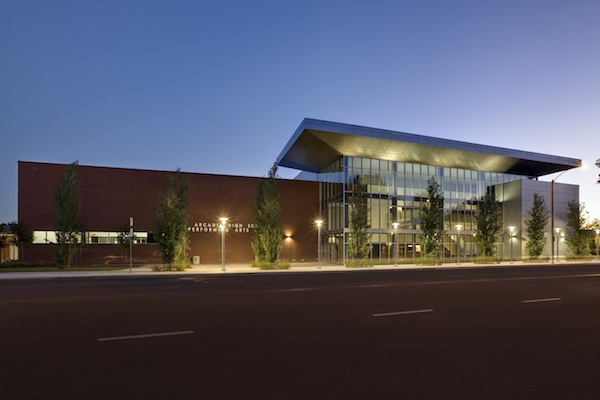A 60-year old wish for the community of Arcadia has finally come true with the opening of Arcadia Unified School District’s new $20 million Performing Arts Center. It was the District’s intent to build an auditorium in 1952 when the high school was originally constructed, but there was no funding. Due to the passage of Bond Measure I in 2006, the District finally had a chance to fulfill this community’s enduring dream.
"We are exceptionally pleased to have realized the dream of providing our students, faculty and community members with a world class performing arts venue that will become a home for the arts in Arcadia,” said AUSD Superintendent Dr. Joel Shawn. “All aspects of the arts are an essential component of a rigorous education for our students and a healthy, vibrant community."
McCarthy Building Companies, Inc., one of Southern California’s foremost building companies specializing in educational facilities, served as general contractor/developer for the facility using Lease/Leaseback project delivery. Constructed on a 4.2 acre site at the northwest end of the Arcadia High School campus, the 40,000 square-foot theater venue opened on October 27, 2012 with an inaugural benefit concert by living music legend Paul Anka.
In addition to being used by the high school for drama, dance and music performances and classes, the new Center will be enjoyed by the entire community, as it is the only performing arts venue in the City of Arcadia. The nonprofit Arcadia Performing Arts Foundation was recently created to support the new center with efforts underway to fund the maintenance and a full-time theater manager for the Center.
Designed by LPA, Inc. the new Performing Arts Center is the latest addition to Arcadia High School’s historic campus. Performing arts, especially music, are extremely important to the Arcadia Unified School District, and this high-concept facility showcases this priority for the Arts through its architecture.
The main performance hall incorporates ground level and mezzanine seating for 1,200 and a stage with capacity for up to 200 musicians. Designed for acoustic performance, this space is equipped with adjustable sound-absorptive panels that allow it to be acoustically “tuned” based on the needs of the performance. In addition, moveable orchestra shells can be utilized to adjust the size of the stage to the performance and the orchestra shell’s acoustical qualities increase the sound projection to the audience. The main hall is also designed with professional lighting and sound systems as well as other state-of-the-art technology making it an exciting venue for the visual arts.
Students can access the main hall from three adjacent classrooms in the Center. Each classroom space has been tailored to instructors’ and students’ needs including a large sound attenuated orchestra room with sound proof practice rooms, instrument storage and a library; a Blackbox/Drama Room with a separate control room and flexible seating for 125 guests; and a Dance Room with a quadruple-sprung wood floor, dressing rooms and a full service backstage facility for scene prop and costumes storage as well as professional stage craft areas. The facility also incorporates a dramatic internal courtyard, lobby and outdoor pavilion areas.
Built with a sloping concrete floor, the steel frame structure features a modern glass, smooth plaster and brick exterior. Interior finishes include cabinetry for music instrument storage, and multiple flooring types such as wood, ceramic tile, carpet, terrazzo and concrete.
Special construction techniques were used to meet the facility’s acoustical and architectural requirements. “A gypsum plaster finish was applied in the theater in lieu of the conventional drywall to increase the density of the walls, along with coffered ceilings in order to provide enhanced acoustical properties within the space,” said McCarthy Project Manager Michael Forys. “We also constructed a 10,000-square-foot scaffold platform to build the 40-foot high ceilings in the main theater.”
Forys noted that the smooth exterior plaster finish provided a unique challenge on the project. “If not finished properly, the exterior walls could look uneven or wavy. To mitigate this challenge, McCarthy spent considerable time with the installing subcontractor reviewing specs, construction details and installation methods prior to the start of the plaster construction to assure that the team would be able to achieve the desired effect in a consistent manner. The proactive quality control for this scope of work helped produce a beautiful end-product exceeding all expectations.”
Forys said that another quality focus of the team was the potential for latent moisture in the concrete slabs that could ultimately effect floor covering adhesion. “Due to recent low VOC legislation changes in the flooring industry, McCarthy has developed a comprehensive flooring coordination program that is utilized to avoid floor issues. In this facility, the program was implemented early in the project and measures were put in place from the foundation on up to reduce concrete slab vapor transmission and maintain the integrity of the finished product,” explained Forys.
“By utilizing Lease/Leaseback procurement of the project, we were able to more effectively work through project challenges during the preconstruction phase that we normally encounter during construction. This alternative delivery also helped to maintain the project budget and provide cost certainty for the District. This was accomplished by conducting a thorough constructability review of the plans while working with the District and design team during preconstruction to create an accurate budget. Also, a lot of time, not normally afforded on hard-bid projects, was spent reviewing the plans and scopes of work with the subcontracting community. This allowed us to provide precise estimates and avoid scope gaps.”
“Delivering high-level of quality was a major priority for this project,” said Forys. “The numerous finish elements (brick, composite aluminum, cement plaster, gypsum plaster, etc.) and their interfaces were all seamlessly integrated. The completed product is a beautiful facility that McCarthy and the District are very proud of and that everyone in the community can enjoy.”
McCarthy is currently overseeing construction projects at 10 elementary and middle schools within the Arcadia Unified School District school facility improvement program including new buildings and modernization.
About McCarthy
Recognized as one of the nation’s few true builders, McCarthy Building Companies, Inc. is the largest educational facilities builder in California (ENR California, July 2012) and the largest general building contractor in California (ENR California, July 2012). The company is committed to the construction of high performance green buildings; progressive job site technology; and safer, faster and more cost-effective execution. In addition to Newport Beach, McCarthy has offices in San Diego, Sacramento and San Francisco, Calif.; Phoenix; Las Vegas; St. Louis; Collinsville, Ill.; Dallas; Houston and Atlanta. McCarthy is 100 percent employee owned. More information about the company is available online at www.mccarthy.com.
Related Stories
| Oct 17, 2011
Aerialogics announces technology partnership with CertainTeed Corp.
CertainTeed to provide Aerialogics’ Aerial Measurement Services to its credentialed contractor base and utilize the technology in its Roofing Products Division.
| Oct 17, 2011
Big D Floor covering supplies to offer Johnsonite Products??
Strategic partnership expands offering to south and west coast customers.
| Oct 17, 2011
Clery Act report reveals community colleges lacking integrated mass notification systems
“Detailed Analysis of U.S. College and University Annual Clery Act Reports” study now available.
| Oct 17, 2011
USGBC L.A. Chapter's Green Gala to feature Jason McLennan as keynote speaker
Chapter to presents inaugural Sustainable Innovation Awards,
| Oct 17, 2011
Schneider Electric introduces UL924 emergency lighting control devices
The emergency lighting control devices require fewer maintenance costs and testing requirements than backup batteries because they comply with the UL924 standard, reducing installation time.
| Oct 14, 2011
AISC develops new interoperability strategy to move construction industry forward
AISC is working to bring that vision to reality by developing a three-step interoperability strategy to evaluate data exchanges and integrate structural steel information into buildingSMART's Industry Foundation Classes.
| Oct 14, 2011
University of New Mexico Science & Math Learning Center attains LEED for Schools Gold
Van H. Gilbert architects enhances sustainability credentials.
| Oct 14, 2011
BD+C Survey on Building Information Modeling: The Good, the Bad, and the Solutions
In a recent survey conducted by Building Design+Construction, more than 75% of respondents indicated they currently use BIM or plan to use it. Respondents were also asked to comment on their experiences with BIM, what they liked and disliked about BIM, and what BIM-related advice they would give to their peers.
| Oct 14, 2011
ACI partners with CRSI to launch new adhesive anchor certification program
Adhesive anchor installer certification required in new ACI 318-11.
| Oct 14, 2011
Midwest construction firms merge as Black and Dew
Merger is aimed at increasing market sector capabilities and building on communication and core contracting competencies.
















